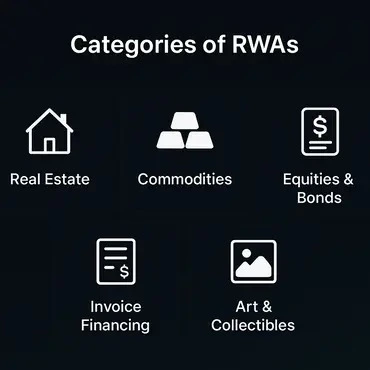Real World Assets: The Future of Tokenization in Blockchain

Exploring Real World Assets and Their Role in Transforming Finance
The world of money is changing fast. People are now combining traditional things like houses, gold, or stocks with blockchain, which is a special digital system. This creates something called Real World Assets (RWAs). RWAs are real things or financial assets that exist in the real world but are shown digitally on the blockchain. This makes it easier to manage, trade, or use them online. As the digital and real worlds of money come together, RWAs and their digital tokens are becoming very important. Let’s see what RWAs are, how they are turned into tokens, and why they matter.
What Are Real World Assets (RWAs)?
Real World Assets (RWAs) are real things or traditional financial items that exist in the real world, like houses, land, gold, art, cars, stocks, bonds, invoices, and patents. On the blockchain, these real things can be turned into digital tokens. These tokens show the value and who owns what, so people can trade them, use them to earn rewards, or use them as collateral in DeFi (Decentralized Finance) platforms.
Why RWAs Are Important
- Easy Access to Money– Many real-world things are hard to sell or trade. Tokenization lets people own just a small part of something big, making it easier to sell or use.
- Anyone Can Invest– People from any country can invest in tokenized RWAs. You don’t need to be rich or live in a certain place.
- Safe and Transparent– Blockchain keeps a secure and clear record of who owns what. This makes trading safe and easy to track.
- More Ways to Use Money– RWA tokens can be used in DeFi for lending, staking, or other activities. This gives both the assets and platforms more value.
Tokenization of Real World Assets
Tokenizing RWAs involves several key steps:
- Digitization- Converting the asset into a digital form.
- Legal Structure- Establishing enforceable ownership through legal means.
- Smart Contracts- Automating transfers, compliance checks, and dividend distribution.
- Custody and Oracles- Ensuring secure custody of the asset and providing real-world data to the blockchain.
Example: A property valued at $1 million can be tokenized into 1,000,000 tokens, each representing a $1 stake. These tokens can be bought, sold, or traded on blockchain platforms.
Categories of Real World Assets

- Real Estate- Fractional ownership of properties via tokenization.
- Commodities- Tokenized versions of gold, oil, or agricultural goods—enabling round-the-clock trading. Examples include gold-backed tokens like PAXG and Tether Gold.
- Equities and Bonds- Traditional securities such as stocks and bonds can be represented as security tokens offering dividends and voting rights.
- Invoice Financing- Businesses can tokenize receivables or invoices to raise upfront capital, offering investors returns upon invoice payment.
- Art and Collectibles- High-value items such as rare art or vintage cars can be represented via NFTs, making them divisible and tradable.
Use Cases of Real World Assets
By bringing RWAs on-chain, the financial landscape unlocks some powerful use cases:
- DeFi Integration- RWA tokens can be used as collateral on platforms like MakerDAO or others, enabling lending, staking, and yield generation.
- Fractional Ownership- Reduces barriers to entryso investors can own portions of high-value assets.
- Faster Trading and Liquidity- Assets can be traded 24/7, anywhere, without the delays of traditional markets.
- Automation via Smart Contracts- Enables programmable compliance, revenue distribution, and governance.
- Increased Access- Makes high-value asset classes available to retail investors globally.
Benefits to TradFi and DeFi
For TradFi
- More efficient trading and settlement of traditional assets.
- Improved global liquidity and broader investor base.
For DeFi
- Stable, real-world-backed assets reduce volatility.
- Bridges credibility gap with regulators and institutions.
Risks and Challenges
- Legal Ownership– Making sure token holders really own the asset can be tricky.
- Safe Storage– The real asset must be kept safe and trusted.
- Correct Value– It is important to know the right value of the asset.
- Data Risks– Real-world information must be correctly and safely sent to the blockchain.
- Rules Are Unclear– Laws are still changing and can be different in each country.
Looking Ahead: The Future of RWAs
As blockchain technology gets better and rules become clearer, more people will start using RWAs. Some new ideas include:
- Connecting RWAs with Central Bank Digital Currencies (CBDCs).
- Using AI to check the value and risk of assets in real time.
- Creating cross-chain marketplaces to make trading easier and faster.
- Making tokenized ETFs or index funds using collections of RWAs.
Conclusion
Real World Asset tokenization is changing the world of money by connecting real things with digital systems. By letting people own just a part of an asset, making it easy to trade, and keeping it safe and clear, RWA tokens let more people invest in things that used to be only for the rich. As laws improve and blockchain technology grows, tokenized real-world assets could become very important for fair, easy, and new ways of using money.





